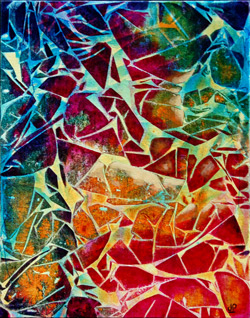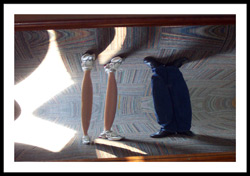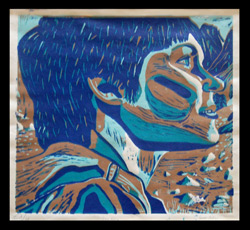
|
Art & Science
Art and science was another theme that was explored during the Congress.
The Fermilab grounds boast unique architecture and art. Founding director Robert R. Wilson, a renowned physicist and an accomplished artist and sculptor, believed that a research laboratory should be a cultural center for the community and the nation.
In celebration of Wilson’s vision, Congress participants created more than 30 works of art for display and/or judging at the Congress. Listed below are those works receiving prizes—see abstracts for all art entries here.
Art Contest Results
< View slideshow of larger images >
Best in Show
| |
 |
| |
The Particle Decay Series, by Kristal Feldt
Photo by Aaron Paden
Enlarge Image |
Kristal Feldt, Undergraduate, University of Kansas
for "The Particle Decay Series," a set of jewelry.
$100 cash prize, and a trip to the American Association of Physics Teachers (AAPT) 2009 WInter Meeting.
Abstract
The goal I wish to achieve in the art field is not to go the average route of replicating organics, but instead bring light to the beauty of science. I seek to design sophisticated art jewelry and small scale sculpture that brings the elegance of scientific phenomena and concepts, particularly in the realm of physics, to the everyday person. I intend to accomplish this by taking my understanding of the literal and conceptual views of different topics (that I do personal research to understand to the best of my ability) and creating something beautiful out of it. In The Particle Decay Series, I created a line of artistic jewelry to express the nature of particle decay through its collision patterns. The set includes a hairpin, necklace, bracelet, earrings, brooch, and ring.
Also see: The art of physics: KU junior’s jewelry, sculpture designs win national prizes, Univ. Kansas website.
1st Place, General Science Category
| |
 |
| |
Fallen, by Glenn A. Marsch
Photo by Phillip Payette
Enlarge Image |
Glenn A. Marsch, Associate Professor of Physics,
Grove City College
for "Fallen," a photograph.
$75 cash prize.
Abstract
A maple leaf has fallen on a road, and rain has fallen atop the leaf. Under the leaf, the stain of water shows adhesion to the pavement, on which it has spread.
1st Place, The Citizen Scientist Category
Cara Taber, Undergraduate, Grove City College
for "Awe," a collage.
$75 cash prize.
Abstract
This collage shows how important it is to get children excited about physics. It also reminds each of us how it feels to stand in awe of both the mystery of physical phenomena and the even more astounding concept that we can understand such amazing things through physics. The citizen scientist wants other people to experience this amazing feeling-- not necessarily a teacher by trade, but still committed to share with others a passion for physics.
1st Place, Future Faces of Physics Category
| |
 |
| |
In Dimension, by Jeanette Powers
Photo by Phillip Payette
Enlarge Image |
Jeanette Powers, Undergraduate, Rockhurst University
for "In Dimension," a painting.
$75 cash prize.
Abstract
The painting begins with a point in the lower left corner. A point is described by zero dimension. A conglomeration of points in a row creates a line, which is one dimensional. Likewise, a collection of lines creates a plane, which is two dimensional. Finally, she approaches three dimensions in the right hand side of her face where an artist's concept of depth, volume and form is taken into account. The grid lines are left behind to show the beings that occupy the physical, spatial dimensions we live in. As you walk past this in a gallery, you experience it moving through time, and it lives with you in four dimensions. Fractal dimensions also enter into this piece. There are instances of a phase transition between laminar flow and viscous fingering, a fractal-like boundary. The underlying texture is created by using crumpled plastic wrap as a sort of stamp, and so is similar to the fractal dimension of the crumpled paper ball. This painting exemplifies the theme Future Faces of Physics both by being a self-portrait of an aspiring physicist and by addressing the emerging science of dynamical systems and fractal dimensions.
| |
 |
| |
The Bubble Chamber Reliquary, by Kristal Feldt
Photos by Aaron Paden
Enlarge Image |
Artist's Choice Award
Kristal Feldt, Undergraduate, University of Kansas
for "The Bubble Chamber Reliquary," a sculpture.
$50 cash prize.
Abstract
The Bubble Chamber Reliquary was a project for my introductory course to metalsmithing. A previous course in astronomy at the university and further research introduced me to the beauty of neutrinos and particle collision, which have become recurring themes in both my sculpture and art jewelry. So I created a spherical container to place symbols of my sister (a more logical mind, symbolized by a Feynman diagram) and myself (a more creative mind, symbolized by the visual representation of particle collision). The reliquary itself is sealed shut (a symbol of the inescapable blood bond between the two of us). The holes, or bubbles , help represent the bubble chamber in which the particle collision occurs and give the observer a peek at the symbols inside. The bubbles might appear to be random at first glance, but a look at the side shows that they actually are symmetrical to the bubbles on the other side.
Curator's Choice Award
| |
 |
| |
Fractalline Fluids, by Jeanette Powers
Photo by Phillip Payette
Enlarge Image |
Jeanette Powers, Undergraduate, Rockhurst University
for "Fractalline Fluids," a painting.
$50 cash prize.
Abstract
This painting represents a dynamic system of the movement of fluid and the drying rate and interactions of acrylic pigment. The fractured surface is created by crumpling cellophane over a wet surface of paint. Pigment is then forced into the channels of the cellophane while the canvas is tilted at an angle, to allow gravity to pull the pigment down through the fractured system. This technique I have developed allows the artist to use the natural mixing that fluid dynamics creates along with the control of the artist to create an art piece which exists on the boundary between order and chaos. The result is a chaotic landscape reminiscent of leaves, cells, rivulets, the cracked dirt of arid land: all chaotic processes which leave a recognizable mark. The pattern is not exact, but exhibits self-similarity at different scales. In my experience, the struggle with creating science-based art is to keep the technical details while still creating art which is warm, human and ultimately still relates to people from all walks of life.
People's Choice Award
| |
 |
| |
Jovian Marbles, by Douglas Parsons
Photo by Phillip Payette
Enlarge Image |
Douglas Parsons, Undergraduate,
Angelo State University
for "Jovian Marbles," a digital painting.
$50 cash prize.
Abstract
Recently, The New Horizons probe - on its way to explore Pluto - passed by the Jovian System and took some rather nice snap-shots of the system. This is not a representation of Jupiter, but rather just a simple gas giant system in orbit around some far off star system.
Honorable Mention Ribbons:
| |
 |
| |
Homogenous DBD, by David Jacome
Photo by David Jacome
Enlarge Image |
David Jacome, Undergraduate, Saint Peter's College
for "Homogenous DBD," a photograph.
Abstract
Although high pressure plasmas usually are manifested as run-away transients such as arcs and lighting in this picture we see a high pressure homogenous plasma formation with a dielectric barrier discharge (DBD). The photograph focuses our attention to the center at the most important part between the two electrodes of the DBD reactor. The background is a blur since the focus of our research is to understand the formation of the plasma. Courtesy: Saint Peter's College, Physics Program, Jersey City, New Jersey.
| |
 |
| |
Transparencies, by Glenn A. Marsch
Photo by Phillip Payette
Enlarge Image |
Glenn A. Marsch, Associate Professor of Physics,
Grove City College
for "Transparencies," a photograph.
Abstract
A still life of a crocus blossom in a shot glass, showing an interplay of light through various materials. Visible light is easily transmitted though the windowpane. Light passes through the water-filled shot glass as well, but refraction through a lens of this shape bends light more. Much of the arborvitae row in the background appears compressed after passing through the shot glass and looks similar to a "fish-eye's view." The diaphanous, white petals of the crocus blossom allow some light of all visible wavelengths to transmit through the petals. Within the blossom, veins of pigment absorb lower-energy, red light, and reflect unharvested violet light to your eyes.
Cara Taber, Undergraduate, Grove City College
for "Seraina, " a linoleum block print.
Abstract
Seraina spent many hours in high school pouring over physics homework with me, and through our joint effort, we passed the class and grew to love physics. Now Seraina studies physics at Case Western Reserve University. Represented here in this linoleum block print is her determination and hope for the future. This determination is also reflected in the background-- the Swiss Alps, a tribute both to Seraina's dual Swiss-American citizenship, and the famous CERN located on the France-Switzerland border. She proudly represents the ever increasing communities of both international and female physicists. No doubt the physics community will see great research in the future from Seraina, probably still proudly sporting her "Schr÷dinger's cat is dead / Schr÷dinger's cat is not dead" t-shirt.
| |
 |
| |
Heel over Heels, by Karen Williams
Photo by Karen Williams
Enlarge Image |
Karen Williams, Associate Professor of Physics,
East Central University
for "Heel Over Heels," a photograph.
Abstract
"Heel Over Heels" photo was taken with a Kodak camera at an art museum in Hot Springs, AR. No 'touching up' or Photoshopping was done on the photo. The photo was taken of a colleague and myself in a 'crazy' mirror. Note also the crazy pattern of the carpet in the mirror.
|











